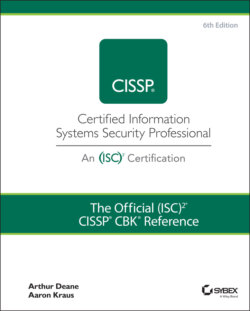Читать книгу The Official (ISC)2 CISSP CBK Reference - Leslie Fife, Aaron Kraus - Страница 144
International Standards Organization
ОглавлениеThe International Standards Organization has developed the ISO 31000 series of standards to identify principles for general risk management and to provide a set of guidelines for implementation. Developed using the consistent language contained in ISO/IEC Guide 73:2009, the ISO 31000:2018 is intended to be applicable to any organization, regardless of the governance structure or industry. The standard encourages the integration of risk management activities across organizational lines and levels to provide the organization with a consistent approach to management of operational and strategic risks.
ISO 31000:2018 is based on a set of eight principles that drive the development of the risk framework shown in Figure 1.7. That framework, in turn, structures the processes for implementing risk management.
FIGURE 1.7 ISO 31000:2018
The eight ISO 31000 principles are described here:
Customized: The framework should be customized and proportionate to the organization and the level of risk.
Inclusive: The appropriate and timely involvement of stakeholders is necessary.
Comprehensive: A structured and comprehensive approach is required.
Integrated: Risk management is an integral part of all organizational activities.
Dynamic: Risk management anticipates, detects, acknowledges, and responds to changes in a timely fashion.
Best available information: Risk management explicitly considers any limitations of available information.
Human and cultural factors: Human and cultural factors influence all aspects of risk management.
Continual improvement: Risk management is continually improved through learning and experience.
To assist organizations in implementing the ISO 31000 standard, ISO 31004, “Risk Management — Guidance for the implementation of ISO 31000,” was published to provide a structured approach to transition their existing risk management practices to be consistent with ISO 31000 and consistent with the individual characteristics and demands of the organization.
While the 31000 series addresses general risk, information security practices are addressed in the ISO 27000 series. The use of the ISO/IEC Guide 73 allows for a common language, but ISO/IEC 27005:2011, “Information technology— Security techniques — Information security risk management,” gives detail and structure to the information security risks by defining the context for information security risk decision-making. This context includes definition of the organization's risk tolerance, compliance expectations, and the preferred approaches for assessment and treatment of risk.
ISO 27005 does not directly provide a risk assessment process. Rather, it provides inputs to, and gets outputs from, the risk assessment practice used by the organization. In this framework, the assessment process may be performed in a quantitative or qualitative manner but must be done consistently so that prioritization can be performed. ISO 27005 further emphasizes the need for communication with stakeholders and for processes that continuously monitor for changes in the risk environment.
The ISO standards have seen broad adoption, in part because of the broad international process in the development of the standards. Further, the standards themselves, while constantly under review, connect to other standards managed within the ISO. This enables organizations to adopt those standards that are appropriate for their businesses and provides a more holistic view of an organizations' risk and compliance activities.
